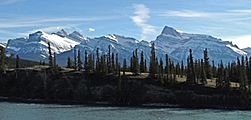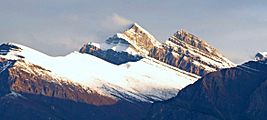Siffleur Mountain facts for kids
Quick facts for kids Siffleur Mountain |
|
|---|---|

Siffleur Mountain
|
|
| Highest point | |
| Elevation | 3,129 m (10,266 ft) |
| Prominence | 386 m (1,266 ft) |
| Parent peak | Mount Loudon (3221 m) |
| Listing | Mountains of Alberta |
| Geography | |
| Location | Alberta, Canada |
| Parent range | Murchison Group Canadian Rockies |
| Topo map | NTS 82N/16 |
| Type of rock | Sedimentary |
| Climbing | |
| First ascent | 1924 |
| Easiest route | Scrambling |
Siffleur Mountain is a tall mountain peak in Alberta, Canada. It stands about 3,129 meters (10,266 feet) high. You can find it in the North Saskatchewan River valley, which is part of the amazing Canadian Rockies.
This mountain is located inside the Siffleur Wilderness Area. Its closest taller neighbor is Mount Loudon, which is about 3 kilometers (1.9 miles) to the southwest. If you are driving on Highway 11, also known as the David Thompson Highway, you can often see Siffleur Mountain. Water from rain and melting snow on Siffleur Mountain flows north into Loudon Creek and then into the Siffleur River.
Contents
What is the history of Siffleur Mountain?
How did Siffleur Mountain get its name?
The name "Siffleur Mountain" comes from the French word "siffleur," which means "whistler." In 1858, a explorer named James Hector chose this name. He picked it because of the loud, shrill whistles made by marmots. Marmots are a type of ground squirrel that live in the area around the mountain.
The name for Siffleur Mountain became official in 1924. This happened when the Geographical Names Board of Canada approved it.
Who first climbed Siffleur Mountain?
The first time someone successfully climbed to the top of Siffleur Mountain was in 1924. The climber was Morrison P. Bridgland. He was a Dominion Land Surveyor, which means he was a person who measured and mapped land.
Morrison P. Bridgland lived from 1878 to 1948. He was famous for climbing and naming many different peaks in the Canadian Rockies.
What is Siffleur Mountain made of?
Siffleur Mountain is made of a type of rock called sedimentary rock. This rock formed over millions of years, from the Precambrian time period all the way to the Jurassic period.
During a major event called the Laramide orogeny, these rocks were pushed and folded. This process caused older rocks to move east and even slide on top of younger rocks.
What is the weather like at Siffleur Mountain?
Siffleur Mountain has a subarctic climate. This means it has very cold and snowy winters. The summers are usually mild, not too hot or too cold.
During winter, temperatures can drop below -20 °C (-4 °F). With the wind chill, it can feel even colder, sometimes below -30 °C (-22 °F).
Images for kids
-
Siffleur Mountain (on the left) next to Mount Peskett (on the right).





